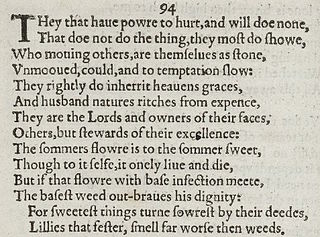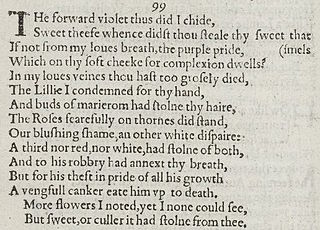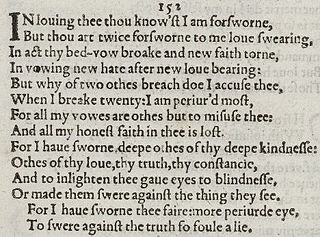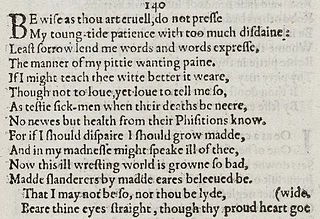| Sonnet 47 | |||||||
|---|---|---|---|---|---|---|---|
 Sonnet 47 in the 1609 Quarto | |||||||
| | |||||||
| |||||||
Shakespeare's Sonnet 47 is one of the Fair Youth sequence, addressed to a well-born young man. More locally, it is a thematic continuation of Sonnet 46.
| Sonnet 47 | |||||||
|---|---|---|---|---|---|---|---|
 Sonnet 47 in the 1609 Quarto | |||||||
| | |||||||
| |||||||
Shakespeare's Sonnet 47 is one of the Fair Youth sequence, addressed to a well-born young man. More locally, it is a thematic continuation of Sonnet 46.
My heart and my eye have reached a mutually beneficial understanding. When my eye yearns for the sight of my beloved, or when my heart is pining, then my eye shares the sight of my beloved (seen in a painting) with my heart. At other times, my heart will share with my eye (in imagination) some memory or thought of the beloved. So whether in painting or in imagination, you are always present with me. It is impossible for you to move outside the sphere of my thoughts; I am always with my thoughts, and they are always with you. Or, if my thoughts are, as it were, sleeping, then your painting will delight my eyes and thus awake my heart.
In both Sonnet 46 and Sonnet 47 the eye, as a party to the trial or to the truce is always used in the singular. The plural eyes is used in line 6 of Sonnet 46 and possibly (at least in the modern version of the text) in line 14 of Sonnet 47 but they do not refer there to the "defendant". In Sonnet 24 both singular and plural are used to refer to the eyes of the speaker.
Sonnet 47 is an English or Shakespearean sonnet, which contains three quatrains followed by a final couplet for a total of fourteen lines. It follows the typical rhyme scheme of the form, ABAB CDCD EFEF GG, and is composed in iambic pentameter, a type of metre based on five pairs of metrically weak/strong syllabic positions per line. The final line exemplifies a regular iambic pentameter:
× / × / × / × / × / Awakes my heart, to heart's and eyes' delight. (47.14)
Lines two and four contain a final extrametrical syllable or feminine ending.
× / × / × / × / × / (×) Or heart in love with sighs himself doth smother, (47.4)
The sonnet thematically continues from the "verdict" delivered by the eye and heart in the previous sonnet. Kerrigan perceives an allusion to the story of Zeuxis and Parrhasius in the "painted banquet" of line 8. Comparing the same image to similar passages in The Faerie Queene , Booth regards the image as symbolic of coldness and insufficiency. Sidney Lee suggests that the conceit of the poem inspired a passage in John Suckling's Tragedy of Benneralt. Edmond Malone notes that the figure of line 3 appears also in The Comedy of Errors ; Edward Dowden notes parallels to Sonnet 75.

Sonnet 94 is one of 154 sonnets written by the English playwright and poet William Shakespeare. It is a member of the Fair Youth sequence, in which the poet expresses his love towards a young man.

Sonnet 22 is one of 154 sonnets written by the English playwright and poet William Shakespeare, and is a part of the Fair Youth sequence.
Sonnet 24 is one of 154 sonnets written by the English playwright and poet William Shakespeare, and is a part of the Fair Youth sequence.

Shakespeare's Sonnet 40 is one of the sequence addressed to a well-born, handsome young man to whom the speaker is devoted. In this poem, as in the others in this part of the sequence, the speaker expresses resentment of his beloved's power over him.

Sonnet 44 is one of 154 sonnets written by the English playwright and poet William Shakespeare. It is a member of the Fair Youth sequence, in which the poet expresses his love towards a young man. Sonnet 44 is continued in Sonnet 45.

Sonnet 61 is one of 154 sonnets written by the English playwright and poet William Shakespeare. It is a member of the Fair Youth sequence, in which the poet expresses his love towards a young man.

Sonnet 91 is one of 154 sonnets written by the English playwright and poet William Shakespeare. It's a member of the Fair Youth sequence, in which the poet expresses his love towards a young man.

Sonnet 99 is one of 154 sonnets written by the English playwright and poet William Shakespeare. It is a member of the Fair Youth sequence, in which the poet expresses his love towards a young man. The sonnet is generally grouped with the preceding two in the sequence, with which it shares a dominant trope and image set: the beloved is described in terms of, and judged superior to, nature and its beauties.

Sonnet 152 is a sonnet by William Shakespeare. It is one of a collection of 154 sonnets, dealing with themes such as the passage of time, love, beauty and mortality, first published in a 1609.

Sonnet 142 is one of 154 sonnets written by the English playwright and poet William Shakespeare.

Sonnet 140 is one of 154 sonnets written by the English playwright and poet William Shakespeare. Sonnet 140 is one of the Dark Lady sonnets, in which the poet writes to a mysterious woman who rivals the Fair Youth for the poet's affection.

Sonnet 139 is one of 154 sonnets written by the English playwright and poet William Shakespeare.

Sonnet 131 is a sonnet written by William Shakespeare and was first published in a 1609 quarto edition titled Shakespeare's sonnets. It is a part of the Dark Lady sequence, which are addressed to an unknown woman usually assumed to possess a dark complexion.

Sonnet 75 is one of 154 sonnets written by the English playwright and poet William Shakespeare. It is a member of the Fair Youth sequence, in which the poet expresses his love towards a young man.

Sonnet 119 is one of 154 sonnets written by the English playwright and poet William Shakespeare. It's a member of the Fair Youth sequence, in which the poet expresses his love towards a young man.

Sonnet 90 is one of 154 sonnets written by the English playwright and poet William Shakespeare. It is a member of the Fair Youth sequence, in which the poet expresses his love towards a young man.
Sonnet 113 is one of 154 sonnets written by the English playwright and poet William Shakespeare. It's a member of the Fair Youth sequence, in which the poet expresses his love towards a young man.

Sonnet 114 is one of 154 sonnets written by the English playwright and poet William Shakespeare. It is a member of the Fair Youth sequence, in which the poet expresses his love towards a young man.

Sonnet 115 is one of 154 sonnets written by the English playwright and poet William Shakespeare. It is a member of the Fair Youth sequence, in which the poet expresses his love towards a young man.
Sonnet 120 is one of 154 sonnets written by the English playwright and poet William Shakespeare. It's a member of the Fair Youth sequence, in which the poet expresses his love towards a young man.